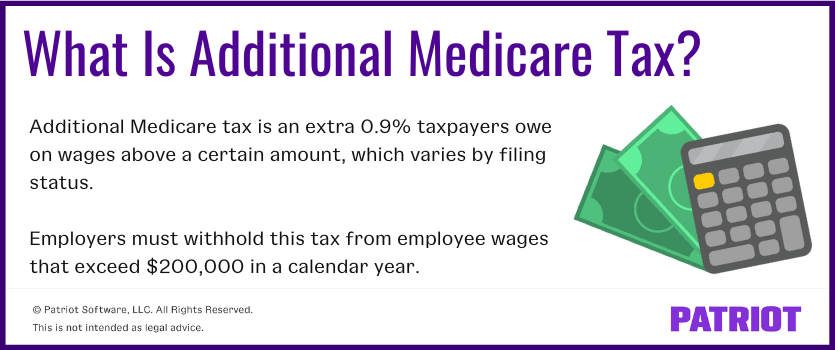Calculate wages. Withhold taxes. Repeat. That’s the cycle of running payroll for you. But every so often, you’ll get a curveball that changes tax rates. And if an employee earns beyond a certain amount, that curveball is the additional Medicare tax.
So, how much do you know about the (spoiler alert) 0.9% Medicare additional tax? Read on for the scoop.
Additional Medicare tax rate
Additional Medicare tax is an extra percentage applied to wages earned above a certain amount (which varies by filing status). It’s an amount that’s in addition to the normal Medicare tax rate of 1.45%.
Medicare tax is an employer and employee tax. This means employers withhold 1.45% of an employee’s taxable wages for Medicare tax and contribute a matching 1.45%. Although Medicare tax is an employee and employer tax, the additional Medicare tax rate is an employee-only tax.
Confused? Our Q&A below should clear up some of the confusion.
What is additional Medicare tax?
The additional Medicare tax went into effect in 2013. It applies to qualifying wages, compensation, and self-employment income.
Like Medicare tax, the additional Medicare tax rate is a payroll tax that funds Medicare benefits, including:
- Inpatient hospital care
- Skilled nursing facility care
- Home health care
- Hospice care
- Medicare program administration
You can learn more about Medicare funding on the U.S. federal government website.
What’s the Medicare supplemental tax rate?
Well, this should come as no surprise (it’s in the title, after all!), but the additional Medicare tax rate is 0.9%.
Again, employees also pay the regular Medicare tax rate of 1.45%. Eligible employees pay Medicare tax (1.45%) and additional Medicare tax (0.9%) on qualifying wages for a total of 2.35%.

Who pays additional Medicare taxes?
Higher-earning employees must pay additional Medicare tax after they earn above their filing status’ threshold amount:
| Filing Status | Threshold Amount |
|---|---|
| Single | $200,000 |
| Married filing jointly | $250,000 |
| Married filing separately | $125,000 |
| Head of household (with qualifying person) | $200,000 |
| Qualifying widow(er) with dependent child | $200,000 |
The additional tax rate applies to wages earned beyond this threshold. For example, an individual filing single would owe the extra 0.9% on wages earned beyond $200,000.
Again, only employees pay this additional rate. Employers do not. If one of your employees meets the requirements, withhold 2.35% from their wages and continue contributing 1.45%.
When do I need to withhold additional Medicare taxes?
Employers must withhold the additional 0.9% tax from employee wages over $200,000 in a calendar year. This is the threshold amount for single, head of household, and qualifying widow(er) filing statuses.
So, what if you have a married employee who files jointly or separately? Disregard their filing status when it comes to payroll tax withholding—the IRS requires that employers withhold the tax from wages over $200,000.
Employees who ask you not to withhold the additional Medicare tax are out of luck. You must withhold the tax on wages over $200,000 regardless of whether the employee will owe the tax or not. Instead, employees who file jointly and won’t meet the $250,000 threshold can claim a credit when filing their individual income tax return.
Begin withholding additional Medicare tax in the pay period you pay the employee wages beyond $200,000. Keep in mind that the IRS does not require that you notify employees before you start withholding it.
How do I deposit and report it?
Like other payroll taxes, you must deposit additional Medicare tax with the IRS and report it. So, is there a difference in how you must deposit and report it? No and yes, respectively.
When it comes to additional Medicare tax, you must:
- Deposit as normal
- Report on a separate line in Form 941 or 944
- Form 941: Report additional Medicare tax on line 5d
- Form 944: Report additional Medicare tax on line 4d
What about Form W-2? Do you need to do any special reporting on Form W-2? Report the total amount of Medicare tax you withhold from an employee’s wages in box 6, Medicare tax withheld. Include both regular Medicare tax and additional Medicare tax withheld.
Employees must report the extra tax by attaching Form 8959, Additional Medicare Tax, to their income tax return.
What if I under-withhold additional Medicare tax?
Here’s the bottom line: You’re liable for any unpaid tax. If you make a mistake and under-withhold the Medicare surtax, you can either:
- Deduct the correct amount from the employee’s wages on or before the last day of the calendar year
- Pay the difference
Catch the mistake in the same year you paid the wages subject to additional Medicare tax? Great! File a corrected return (e.g., Form 941-X) and make an interest-free adjustment for the amount.
Where can I go for more information?
If you’re hungry for more must-have additional Medicare tax information, check out the IRS website.
Forgetting payroll tax rates is so last decade. Let Patriot’s payroll software do the calculations for you! Sign up to get your free trial today.
This is not intended as legal advice; for more information, please click here.


